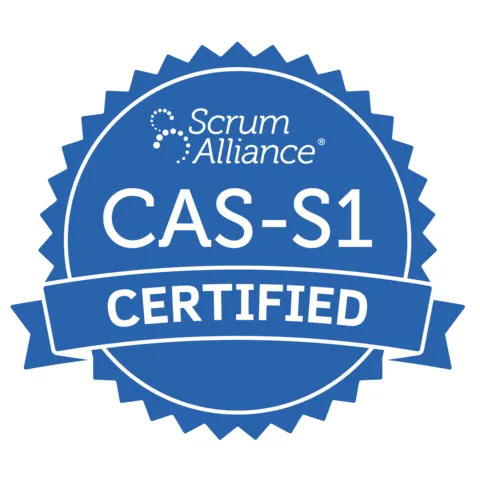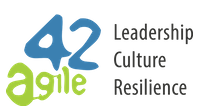Webinar | Implementing Agility at Scale
In our latest webinar, Implementing Agility at Scale, hosted by Giuseppe de Simone and Lothar Fischmann, we explored the intricacies of scaling. The discussion offered valuable insights into the challenges involved in transitioning to Agile frameworks on a larger scale.
De Simone and Fischmann, seasoned experts in organizational agility, provided a comprehensive overview of three main approaches to scaling: pattern-led, principles-led, and practice-led. They shared that implementing agility at scale requires a holistic approach that integrates various perspectives, fosters open communication, and embraces adaptability. Organizations can pave the way for smoother transitions and more resilient operations by addressing challenges collaboratively and aligning strategies with business objectives.
Watch the full webinar below, or read on for six key takeaways.
Watch: Implementing Agility at Scale
1. It’s Important to Identify Your Scaling Goals and Challenges
As the webinar opened, De Simone defined the primary goal of scaling as enabling an organization to increase its capacity without necessarily increasing the headcount. This contrasts with the common misconception that scaling is solely about growing the team.
Participants voted in a poll to share the challenges they have encountered in scaling efforts. Some of these responses included resistance to change, operational issues, lack of strategic goals, leadership concerns, and bureaucracy.
De Simone emphasized that resistance to change often stems from top-down changes from leaders. This tends to occur when the reasons or benefits are unclear to teams. Organizations need to ensure that changes are meaningful and well-aligned with strategic objectives.
2. There Are Four Critical Choices to Make When Scaling Agile Teams
There are four interconnected choices involved in scaling. Each choice has implications for team structure, autonomy, coordination, and speed of delivery. By carefully considering these choices in alignment with their strategic goals and organizational context, organizations can make informed decisions to optimize their scaling efforts.
- Product Breadth: There are many ways to define and understand a product. Most people think they have a clear definition of their product. But, De Simone mused, if you ask five people in your organization for that definition, you’ll likely end up with five different definitions – some of which may be very broad while others are specific. De Simone outlined the example of a banking product. At first, it may seem fairly broad and simple: the key product is the online banking service. But there are also insurance and loans, credit cards, the mobile banking app – and even within the app, there’s Android and iPhone. When you think about it, these could all be considered separate products. How you define their scope or breadth has implications for team structure, backlog management, and alignment with customer needs.
- Components vs. Features: Organizations must decide how to structure their teams based on either component specialization or feature delivery. According to De Simone, component-based teams focus on specific layers or components of the system. Feature teams, on the other hand, have all the necessary skills to work on any component in the system. In addition, they can make decisions and implement features autonomously to deliver value to the customer. Each approach has advantages and challenges, including managing dependencies, autonomy, and collaboration.
- Efficiency vs. Effectiveness: This choice pertains to team organization and resource allocation. Efficiency-oriented teams are specialized, with members dedicated to specific roles like programming, testing, or UX. On the other hand, effectiveness-oriented teams are cross-functional. According to De Simone, “They focus on delivering the most important item as fast as possible.” Organizations need to weigh the benefit of having specialized teams versus increasing the speed of delivery when implementing agility at scale.
- Product Ownership: De Simone elaborates that organizations must decide whether to have one Product Owner per team or one Product Owner per product. Having a Product Owner per team can lead to increased autonomy, but may result in fragmented ownership and coordination challenges. Conversely, having a Product Owner per product reduces the cost of the time taken to coordinate the teams. However, this requires broader skills and may limit team autonomy.

3. There are Three Main Approaches to Implementing Agility at Scale
According to Fischmann, “We can distinguish between three main approaches to scaling agility: the first is pattern-led scaling; the second is principles-led scaling; and the third is practice-led scaling.”
- Pattern-Led Scaling: This approach allows organizations to apply scaling based on the specific situation and context they face. In this approach, we understand the patterns of problems in our particular business context. Therefore, we can apply solutions that have already been proven to work well in this context. According to Fischmann, the advantage of using this approach is that we’re approaching the problem within the specific context of our business.
- Principles-Led Scaling: In this approach, organizations align their behavior and decision-making with Agile principles and values. This approach fosters a strong Agile culture, but Fischmann notes, “If you only come from a principal perspective then it may be hard to relate agility to any specific business problems”.
- Practice-Led Scaling: This approach involves implementing tactical practices and frameworks to drive agility at scale. It emphasizes hands-on learning and involves applying specific practices to gain a deeper understanding of underlying principles.
For a deep dive into Agile principles, check out our Agile Foundations e-learning course.
Fischmann elaborates that there are interdependencies between the three main scaling strategies: principles-led, pattern-led, and practice-led.
- Principles-Led governs Pattern-Led and Practice-Led: This means that the principles and values of agility serve as the foundation for both pattern-led and practice-led approaches. Organizations rely on Agile principles to guide their decision-making and problem-solving processes, whether they’re identifying patterns or implementing specific practices.
- Practice-Led helps us understand Principles-Led: “By practicing certain rituals, teams get a deeper understanding of why these rituals are important, and they will get a better understanding of the principles behind them,” Fischmann explains. Through practical application, individuals and teams internalize the core concepts of agility and how they translate into real-world scenarios.
- Practice-Led is used to manage Pattern-Led: Organizations leverage practice-led approaches to address specific patterns or challenges they encounter. Practices serve as tools or techniques to manage and navigate complex patterns in the organization. For example, if an organization identifies a pattern of communication breakdowns, teams may implement practices such as Daily Stand-up meetings or Retrospective sessions. In doing so, teams can improve collaboration and transparency.
Overall, these relationships emphasize the importance of aligning principles, patterns, and practices when implementing agility at scale. Each approach complements the others, contributing to a holistic and sustainable Agile transformation journey.

4. Practice-led Scaling Has Three Sub-Categories
According to Fischmann, we can further categorize practices into framework-led, methodology-led, or toolbox-led approaches. Each of these offers distinct levels of structure and guidance.
- Framework-Led Approaches: Fischmann explained that framework-led practices offer a minimal set of guidelines and processes to follow, allowing teams to be flexible and adapt based on their specific needs. Frameworks, such as Scrum or Kanban, outline key roles, events, and artifacts, providing a foundation for teams to organize their work and interactions.
- Methodology-Led Approaches: Methodology-led practices involve pursuing knowledge, with clear instructions on how practices should be executed. This approach uses a pre-configured heavyweight external model. Contained within the model are many methods and practices describing how to perform all the activities. The model is then applied to your current organization. This is a popular approach as the methodology removes the need to make complex contextual decisions. It is often laden with risk for the same reasons. A key disadvantage is that it doesn’t take the individual organization’s context and challenges into account when scaling agility.
- Toolbox-Led Approaches: Toolbox-led practices rely on tactical tools and techniques for addressing specific situations or challenges. Fischmann used the example of a tool that has been successful in one situation and proposes that it can be applied elsewhere in the organization to tackle similar issues. Instead of following predefined frameworks or methodologies, teams assemble a toolkit of practices based on their context and requirements. Organizations select and adapt these practices as needed to address their unique challenges and achieve their specific goals.
By understanding these distinctions, organizations can choose the most suitable practice-led approach for their scaling efforts. This decision takes into consideration factors such as complexity, organizational culture, and desired level of flexibility. Whether they opt for a structured framework, a comprehensive methodology, or a flexible toolbox approach, aligning practices with organizational goals is essential to successfully implement agility at scale.
5. Three Core Competencies Underscore Agile Scaling
- Scaling/Engineering Skills: These include the technical expertise and capabilities required to scale Agile practices effectively within an organization. De Simone elaborated on this by saying that scaling/engineering skills are essential for designing scalable systems. These skills are also crucial for ensuring the smooth integration of Agile practices across teams and projects.
- Organizational Culture: Organizational culture is crucial in scaling agility and driving successful transformation initiatives. It encompasses the values, beliefs, norms, behaviors, and practices that shape how people work together within an organization. “When you scale, you need to set up a kind of organizational culture that is prepared for scaled collaboration, cross-team collaboration, and customer collaboration,” De Simone concludes.
- Change Management: Change management involves understanding the human side of change, addressing resistance, and ensuring smooth transitions during the transformation journey. De Simone highlighted that change management is a delicate change process. Therefore, it’s essential to be cautious with the approach you choose. You cannot simply create a goal, devise a grand plan, and expect to transform multiple teams instantaneously; it doesn’t work like that.

6. We Can Identify Three Principles Of Organic Scaling
Three principles provide a guiding framework for organizations seeking to implement agility at scale organically. By focusing on value delivery, making culture explicit, and validating change in small increments, organizations can cultivate sustainable growth.
- Focus on Value Delivery: As De Simone advises, “focus on value delivery and removing unnecessary synchronization.” When you prioritize delivering value, your organization can streamline its processes. In doing so, the organization focuses on activities that directly contribute to customer satisfaction. This principle guides strategic choices, such as determining the number of Product Owners (POs) and feature teams. It also determines the size of the product itself.
- Make Your Culture Explicit: Building on the foundation of value delivery, this principle highlights the significance of organizational culture in scaling agility. Organizations can foster an environment with clearly defined and shared values, norms, and behaviors across teams by making culture explicit.
- Validate Change in Small Increments: As De Simone explains, the only way to scale agility is by using an Agile approach. Instead of implementing large-scale transformations all at once, organizations should adopt an iterative and incremental approach to mitigate risks, gather feedback, and make course corrections as needed.
Scrum Alliance has launched Certified Agile Skills – Scaling 1 (CAS-S1). Sign up to learn more about the frameworks, methods, and principles behind Scaling.










